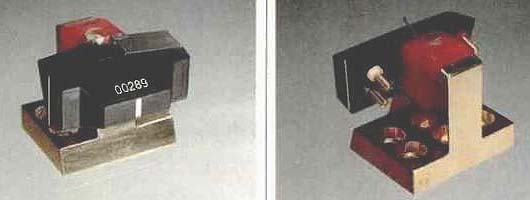
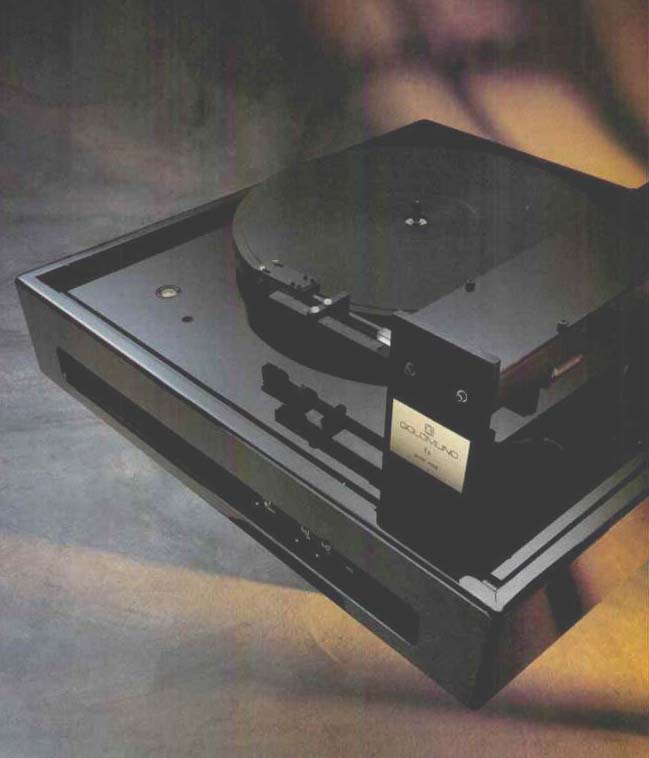
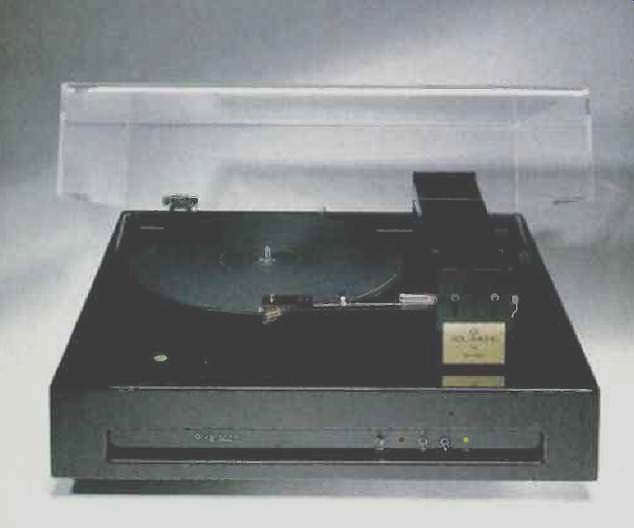
Manufacturer's Specifications:
Turntable:
Drive System: Direct, with quartz-regulated speed control.
Speeds: 33 1/3 and 45 rpm.
Resonance Frequency of Suspension: 3 Hz.
Platter Construction: Methacrylate with peripheral lead inserts.
Platter Weight: 7 lbs (3.2 kg).
Weight: 46 lbs. (20.9 kg), including tonearm.
Dimensions: 20 in. W x 8 1/8 in. H x 20 in. D (51 cm x 22 cm x 51 cm).
Tonearm:
Type: Linear-tracking, servo.
Tracking Error: Maintained within ±0.1° by servo and infrared sensor.
Effective Length: 8 1/16 in. (20.5 cm).
Damping: Adjustable, fluid.
Main Resonance: 10 to 14 Hz, depending on cartridge.
Vertical Tracking Angle: Adjustable.
Cartridge Weight Range: 4 to 20 grams.
Headshell: Detachable, with adjustable overhang.
Cartridge:
Type: Moving coils, on cantilever axis.
Stylus: Trigon parabolic line contact, 7 x 35 µm.
Estimated Stylus Life: 1,500 hours.
Cantilever: Boron pipe.
Tracking Force: 2 grams, ±0.2 gram.
Vertical and Lateral Compliance: 7 mm/N.
Mass: 6.4 grams.
Trackability: 80 µm at 315 Hz.
Vertical Tracking Angle: 23°.
Output Level: 0.7 mV for 5-cm/S recorded velocity at 1 kHz.
Balance: Within 0.1 dB at 1 kHz.
Channel Separation: 35 dB at 1 kHz.
Output Impedance: 50 ohms.
Optimal Load Impedance: 50 ohms, ± 1 ohm.
General Specifications:
Prices: Turntable and tonearm, $5,690; cartridge, $1,950.
Company Address: c/o International Audio Technologies, 1387 Willard Rd., Suite J, Chantilly, Va. 22021.
Goldmund is a Swiss firm that has earned an enviable reputation in audiophile circles as a producer of excellent turntables. The company began by making a servo-controlled linear-tracking arm, which has gone through several revisions to become the T3F (now available for $4,990). Two years later, in 1979, they introduced the Studio turntable ($3,590). This was followed in 1983 by the Reference, designed to be the ultimate turntable, with no cost restrictions whatever; it is still available by special order at a cost of $27,400. The Studietto, also released in 1983, was more affordable at $2,195.
The ST4 reviewed here is Goldmund's first turntable to be sold complete with tonearm, and is intended to approach the sonic attributes of their original products at a much more reasonable price. It uses the drive and base from the Studio Mk. IV turntable, and the motors and design principles of the T3F arm, together with servo electronics. While the servo electronics of the T3F are in a separate, rack-mountable box, the simplified servo circuits for the arm used in the ST4 are mounted within the turntable base.
To complete the package, Goldmund has arranged with Peter Suchy of Clearaudio to provide a special cartridge that they have designated the Goldmund Gold. I tested the Goldmund ST4 turntable and tonearm with the Goldmund Gold cartridge.
The glossy finish of the ST4 is very striking, but after working on the initial setup adjustments, I realized how clearly fingerprints stand out on its mirror-like surface.
These are easy to remove, however, and I was able to restore everything to original pristine appearance by merely wiping the surfaces with my pocket handkerchief. The turntable platter surface and the tonearm tube and sensor rail are finished in dull black, providing an interesting contrast. I noticed that Goldmund has added a nice touch by mounting a bubble level in the top of the turntable's suspended main platform, which makes the balancing adjustments quite easy. The operating controls for speed change (33 1/3 and 45 rpm), power, and tonearm lift are located on a recessed panel in the front of the turntable base. Unless you mount the ST4 high up on a shelf, you will have difficulty reading the labels on the switches.
I was surprised at the tonearm position. I am used to seeing linear-tracking tonearms mounted with their horizontal tracks behind the platter, but the ST4's arm is mounted with its track on the right side of the platter, running from front to rear. Since the arm then comes to its rest in front of the platter, you must lift a record over the arm and its tracking-sensor tube to place the record on the platter. This position also makes it harder to find the desired groove on a record before lowering the arm. During the testing and auditioning, I operated the ST4 from what would normally be its left side, having previously memorized the functions of the three switches. Unfortunately, only after my testing was complete did Goldmund's importer mention that the top plate can also be mounted with the arm track behind the platter.
The arm assembly seemed very sturdy. I could detect no play in the bearings when I tried to elicit movement between the armtube and the pivot bearings by holding the gimbal steady in one hand while I tried to pull, push, and twist the armtube. This is as it should be. The friction of the tonearm in the traverse mode was also extremely low.
When I performed my usual "tap" test on the armtube, I was surprised that the "tick" sound was very uniform all the way from the headshell to a point just forward of the gimbal bearings; most armtubes exhibit some change in the character of the sound when tapped at various points along their length. This indicates to me that the damping of mechanical energy in the ST4 armtube is quite extraordinary. I was also very impressed by the level of finish and apparent precision of the parts and assembly.
=============
MEASURED DATA
ST4 Tonearm
Pivot-to-Stylus Distance: 7.87 in. (200 mm).
Pivot-to-Rear-of-Arm Distance: 1.25 in. (32 mm).
Overall Height Adjustment: 1.0 in. (25.4 mm).
Tracking-Force Adjustment: Sliding counterweight.
Tracking-Force Calibration: None; separate gauge required.
Cartridge Weight Range: 2 to 10 grams.
Counterweights: 145.5 and 181.5 grams.
Counterweight Mounting: Direct to armtube.
Sidethrust Correction: None required.
Pivot Damping: Fluid in trough.
Lifting Device: Motorized, controlled by toggle switch.
Headshell Offset: None required.
Overhang Adjustment: Slotted cartridge mounting holes.
Bearing Alignment: Excellent.
Bearing Friction: Extremely low.
Pivot Bearing Type: Two vertical and two horizontal jeweled pivots in gimbal arrangement.
Track Bearing Type: Eight roller bearings, four for horizontal movement and four for side-to-side stability.
Lead Torque: Negligible.
Arm Lead Capacitance: Left, 90 pF; right, 84 pF.
Arm Lead Resistance: Left, 0.9 ohm; right, 1.1 ohms.
External Lead: None supplied.
Base Mounting: Directly to ST4 turntable base.
Gold Cartridge
Coil Inductance: Less than 100 µH, left and right.
Coil Resistance: Left, 49.0 ohms; right, 48.6 ohms.
Output Voltage: Left, 0.160 mV/cm/S; right, 0.158 mV/cm/S.
Tracking Force: 2.1 grams.
Cartridge Mass: 5.1 grams.
Microphony: Extremely low.
Hum Rejection: Very high.
Rise-Time: 12 uS.
High-Frequency Resonance: 25.1 kHz.
Low-Frequency Resonance: 8.0 Hz, in ST4 tonearm.
Low Frequency 0: 2.87, in ST4 tonearm.
Recommended Load Resistance: 47 kilohms to 50 ohms.
Recommended Load Capacitance: Unaffected by 500 pF or less.
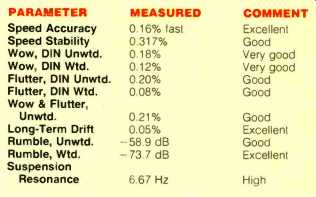
=============
Features
The ST4 turntable uses a direct-drive motor with a speed servo system controlled by a quartz reference oscillator and associated electronic drive circuitry. The motor is fastened directly to the main platform, which is about 0.3 inch thick, while the servo system's circuit board is mounted directly beneath the tonearm. The methyl methacrylate platter is 12 3/16 inches in diameter and 3/4 inch thick, and it weighs 6 pounds on my scale. Ten counterweights, each 1 3/8 inches in diameter, are mounted in holes around the platter's bottom periphery to increase inertia and ensure rotational stability.
Goldmund has placed much emphasis on the unidirectional transmission of energy through the various parts of the ST4 tonearm and turntable to the structure on which it rests.
The objective, which the company calls mechanical grounding, is to provide a "mechanical diode" design that allows energy to be transmitted in one direction only-that is, from the tonearm and turntable, through the three Delrin feet on the turntable base, to the platform or shelf beneath-without allowing energy to be transmitted back from the outside. Goldmund also makes cones that can be used in place of the feet; the company states that these cones improve vibration evacuation efficiency" and "provide the last mechanical diode link in the Goldmund Mechanical Grounding chain."
The platter is isolated from the motor except at the chrome-plated spindle, which is tapered at the top, and the tops of three hex-head bolts. These bolts pass through a disc, made from the same acrylic resin as most of the turntable's other major components, which isolates the rotating outer part of the direct-drive motor. The mechanical energy is transmitted through the bolts from the platter to the motor, which is in turn fastened to the main platform. The center of the platter is not directly coupled to the motor because a precision-machined Teflon sleeve, with an outer diameter of 0.89 inch, is between the spindle and the platter's 0.9-inch center hole. This may sound a little complicated, but the intention is to provide energy isolation except where energy transfer is desired-that is, from the platter, through the three bolts, to the motor, and then to the main platform. The main platform also acts as an energy sink for the tonearm, because the tonearm's two side supports are fastened directly to it. The main platform, the tonearm horizontal structure, and the turntable base are also made from methyl methacrylate, which should aid in keeping undesired mechanical energy away from the stylus/groove interface, where it can color the sound. At the bottom center of the platter is a recessed area, 5 3/16 inches in diameter, to allow clearance for the 4 3/8-inch diameter plastic disc fastened to the rotating outer part of the motor.
The top of the platter is also recessed at the center and the edge to allow clearance for the center label area and outer rim of a record; this ensures a close contact between the bottom surface of the record and the turntable platter.
Because the platter and the record are made of similar materials, most of the mechanical energy in the record, caused by stylus vibrations in the disc's groove, will be absorbed into the platter instead of making its way back to the stylus, where it would be picked up again as delayed vibration that could color the sound.
The main platform is a little over 0.3 inch thick and is supported by three coiled springs. One spring is situated directly under the tonearm, in the middle of the right side; the other two are under the left side of the main platform, at the front and rear. All of the springs are 2.5 inches long (when uncompressed) and 2 1/4 inches in diameter, but each is wound with a different number of turns and is therefore color coded so it can be placed in its proper position. There are felt rings between the springs and the underside of the main platform.
Additional felt rings are inside the plastic cups that form part of the turntable's leveling system. The cups are mounted on long bolts fastened to the turntable base. To adjust the height of the main suspension platform, one turns these bolts, usually while watching the bubble level, using a tool inserted from above through holes in the platform. The long bolts pass through the bottom of the turntable base, where rubber feet are threaded onto them. Turning these feet allows the outer base to be leveled. One of the feet is tapered to allow easier transfer of energy from the turntable base to the platform on which it rests. The feet add about 1 inch to the height of the turntable base and cover assembly, which is about 7 3/4 inches, making the total height 8 3/8inches with the cover closed. The turntable base measured 19 3/4 inches square, which gives you some idea of the space required for the ST4-especially when you allow for raising the lid to change records. The cover is made from 1/8-inch clear acrylic plastic and has a rounded top at its front and back.
The tonearm's horizontal tracking assembly is 12 3/16 inches long and 2 3/16 inches wide, including the two end supports that mount to the turntable platform. After height adjustment, the traverse assembly can be locked in place with horizontal screws that pass through inch-long vertical slots on each support. The arm's height is adjustable to suit cartridges of different sizes and to fine-tune the vertical tracking angle. The traverse assembly is raised or lowered by adjusting four vertical screws located under the polished top cover (which can be lifted off after removing the four screws securing it). Once the correct height has been determined visually and aurally, the four horizontal screws on the side posts are tightened to lock this correct setting.
Then, in order to provide a single transmission path for unwanted mechanical energy, three of the vertical screws are backed off until the transverse part of the arm rests on a single screw.
The round armtube's diameter changes gradually, from 0.375 inch at the front to 0.395 inch just before the pivots.
The pivots consist of a gimbal arrangement of two horizontal and two vertical jeweled bearings. Because the ST4's pivot to-stylus distance is about 8 inches, comparable to that of normal, pivoted tonearms, vertical motion caused by record warp has much less effect on tracking than it does on other linear-tracking tonearms, which have short armtubes.
The headshell is securely attached by four Allen-head screws to a block at the end of the armtube. The left- and right-channel signal leads, each a very thin, twisted pair, exit from the horizontal traverse part of the tonearm, as do the seven leads for tonearm servo control. All these leads are fed through a slot in the turntable's main platform, where the seven control leads connect to the servo-control circuit board located under the tonearm. The signal leads are brought through a hole in the turntable base near the rear of the horizontal part of the tonearm. These leads are soldered to a pair of gold WBT phono connectors mounted on the vertical support of the tonearm. Leads are not normally supplied with the ST4, but Goldmund strongly recommends the use of MIT cables. I used a pair of 1-meter MIT cables while testing and auditioning the ST4.
A sliding counterweight is used to set the tracking force; after it is adjusted, it is locked in place by an Allen-head setscrew. Various weights are available for cartridges of different mass so that the correct position will always be near the pivots; this ensures that the effective mass, at the stylus tip, will be as low as possible.
The horizontal traverse portion of the ST4 arm consists of a set of four roller bearings. Two of these bearings are on a felt track; the other two are in direct contact with the aluminum rail and are slightly larger in diameter to make up for the absence of the felt. This system allows a direct path from the tonearm to the base for unwanted mechanical energy.
There are also four more bearings, on the front and back of the carriage, for stability; these bear against the side surfaces of felt-covered tracks. The upper part of the carriage is an epoxy/glass printed circuit board that carries the control signal leads to the arm lift motor, located on the underside of the traverse system, and to the servo-control motor at the end of the arm's horizontal structure. This latter motor drives the traverse carriage by means of a 10 1/2-inch long rubber belt that passes around a 3/8-inch pulley on the drive shaft and around a similar pulley at the other end of the horizontal structure.
The lift motor operates a cam that raises the armtube when the sensing system is actuated by the lead-out groove of a record. When this happens, a claw (which normally grips the belt that slowly drives the horizontal carriage toward the center of the record) opens up, freeing the belt from the drive system.
Horizontal movement is determined by the action of a photocell, mounted on a fixed sensing arm that is parallel to the armtube, and a vane that is attached to the armtube just behind the headshell. Normal, small movements caused by the slow spiral of the record grooves cause the tonearm's horizontal drive motor to move the belt by slight amounts.
When the lead-out groove is sensed, the horizontal drive system is disengaged and the lift motor operates to raise the stylus out of the record groove. By using separate motors for each operation, Goldmund can optimize each motor's design and location.
Tonearm damping is provided by a paddle, or vane, attached to the tonearm near the pivot and riding in a fixed trough. Viscous fluid in the trough impedes quick movements of the vane, thereby damping the armtube.
Power for the turntable and tonearm motors and for the control electronics is provided by an external 12-V d.c. supply. It can deliver 300 mA and measures 4 3/8 x 2 3/8 x 1 1/4 inches. This supply is connected to the turntable by a thin cable with a locking plug that mates to a socket in the left rear of the turntable base. A thin ground wire is also provided to connect the metal parts of the turntable to an appropriate ground point on a preamplifier. Three tiny access holes in the turntable base, near the tonearm, allow adjustment of the servo system for vertical cueing speed, delay between horizontal corrections, and the speed of those corrections.
The manufacturer recommends the use of their optional Relief Clamp, which can be placed on a record over the label area and tightened with a knurled knob. This ensures good contact between the bottom surface of the record and the top of the turntable platter, allowing any delayed mechanical energy in the record to be conducted away from the stylus and dissipated so it cannot reappear and color the sound.
The total weight of the Goldmund ST4 turntable system is about 46 pounds. This is quite reasonable for a turntable of its size.
The cartridge used during the measurements and listening sessions was the Goldmund Gold, a special high-output moving-coil design made especially for Goldmund by the German company Clearaudio. The body of the Gold is wide at the front and the output pins are at the rear of this wide section, which is quite unusual. The cartridge is so wide, in fact, that the plastic stylus protector, which should be in place when the system is not in use, must be slipped on from the rear of the cartridge body. The Goldmund Gold has an unusual method of holding the stylus cantilever in the magnetic field, in that it employs no damping materials; however, I do not have any further details at this writing. I did notice, during the initial setup checks, that there was little or no internal damping applied to the stylus system.
Because the cartridge's high output allows its use in moving-magnet as well as moving-coil inputs, I tried output loads that ranged all the way from the recommended 50 ohms to the 47 kilohms typical of moving-magnet input circuits. Changing the load did not change the cartridge's frequency response or damping; only its output level changed. I found this most interesting.
Measurements and Listening Tests
The usual procedures were employed in evaluating the Goldmund ST4 turntable and tonearm and Gold cartridge.
The technical measurements preceded the listening sessions to ensure that everything was set up and adjusted for optimum performance. This proved to be very worthwhile, because during the setup I could hear definite improvements in the sound as I brought the system into optimum adjustment. For example, the VTA adjustment proved to be rather critical, as did the amount of viscous fluid in the trough of the damping system.
After the setup and technical measurements, the members of the listening panel auditioned the Goldmund ST4 turntable tonearm and Goldmund Gold cartridge versus my reference system. Twelve different recordings were used to evaluate the quality of the sound of various instruments and types of music and singing. The panel members were asked to rate the systems, which were designated "A" and "B," from 0 to-5 for each category of music and instrumental sound characteristics. They were also encouraged to write down comments and cautioned not to talk or visually convey their feelings during the session.
Figure 1 shows the frequency response and interchannel crosstalk of the Goldmund Gold cartridge in the ST4 tone arm. The rise in crosstalk in the low-frequency range is an artifact of the B & K 2010 test record, but the rest of the range indicates excellent separation between the channels.
The response is also excellent because of its smoothness and the close channel matching through the critical midrange; there is no indication of the sagging response in this range that is so prevalent with other cartridges. Comments by some panel members that certain instruments sounded "slightly forward" compared to the reference system might be correlated with this smooth response. The slight rise at around 20 kHz could not be directly correlated with any comments, at least any negative ones.
Figure 2 shows that the low-frequency resonance of the tonearm mass and cartridge compliance, for the left and right channels, is at 8.0 Hz and is reasonably well controlled. This rise did not seem to have caused any deleterious effects on the reproduced sound-at least I wasn't able to correlate it with any comments by the listening panel.
Figure 3 is very interesting because it shows that the ST4 tonearm exhibits the same effective mass in the vertical and horizontal planes, which is not the case for most linear tracking arms. The effective mass, i.e., the mass as it appears at the stylus tip, interacts with the cartridge cantilever's compliance to produce a mechanical resonance; it is this resonance that causes the rise in output at 8 or 9 Hz seen in Figs. 2 and 3. If severe, this resonance can make the bass sound boomy or even make the stylus mistrack when the record contains strong bass signals. Usually most of the mass of a linear-tracking tonearm is in the horizontal plane, but the Goldmund ST4, by the use of a relatively long armtube, has both planes of motion well matched and under control.
A slow sweep from 20 to 1,000 Hz was performed to see if there were any mechanical resonances (Fig. 4). The left channel has two small steps below 40 Hz and a slight step at about 450 Hz, but these are so minute that the mechanical integrity of the cartridge, its mounting, and the tonearm structure and bearings have to be considered of the highest quality-especially when one considers the complexity of the system and the large number of items that could cause problems if the design were not as good as it proved to be.
The result of the mechanical impulse test is shown as an output versus time plot in Fig. 5. The rapid undulations indicate that most of the energy is in the mid or upper frequency range This also is a technical verification of the subjectively perceived "tick" sound I mentioned earlier when I performed the tap test. Figure 6 shows the average of the spectra from 16 mechanical impulses applied to the arm. There is an output peak at 1,650 Hz as well as a large amount of energy in the range from 4,400 to 4,700 Hz. All of the members of the listening panel made comments about the "sharp," "bright" quality of sound from the ST4, which might very well be correlated to this characteristic of the tonearm and Gold cartridge combination.
Figure 7 shows interchannel phase relationship as a left versus-right 'scope display. Perfect interchannel phase correlation would produce a single 45° line. Figure 8 shows the interchannel phase correlation as a function of frequency.
At 20 kHz it is 75°, which can be converted into a time delay between the left and right channels of 10.4 uS. Some people may argue that this is too small an amount to matter, but I am not prepared to do so. The fact that the random character of the pink noise displayed in Fig. 8 is very similar to that of a stereo recording with good spatial effects causes me to withhold judgment. While I always rely on the comments of the listening panel when I write reports for Audio, I must admit that I do listen to the sound produced by test records, such as the B & K 2011 pink-noise test, when I am setting up and measuring the system. Don't laugh; I find out some very interesting things that I can later correlate to comments made by the panel members during the listening sessions. In fact, their positive comments about the spatial characteristics of the ST4/Gold combination, which I think some reviewers call "soundstage," may be due, at least in part, to the lack of precise interchannel phase correlation.
I divide spatial characteristics into two separate categories, width and depth. The width of the sonic presentation can be enhanced by the reproducer beyond that actually present in the original recording. "Holographic" processors do this by manipulating phase and delay between channels; these techniques have been well known at least since the '50s. Depth is a function of the ratio between direct and reverberant sound, and it is not an exclusive feature of stereo reproduction since it is also present in mono recordings. The ST4 tonearm and Gold cartridge reproduced a very good sense of front-to-back depth, according to the comments made by some of the panel members.
Figure 9 shows the output of the Gold cartridge for the two highest signal levels on the B & K 2010 test record. A touch of distortion can be seen in the top trace, but it really becomes apparent in the bottom trace, where the cartridge is tracking the 25-cm/S signal. This would still be good performance for most cartridges, but at the price of the Gold it should be better. This lack of ability to track the highest recorded levels was demonstrated only once during the listening sessions. During that one particular passage, even the reference system exhibited slight mistracking, but with the ST4/Gold combination it was obvious.
Figure 10, the spectra for the two signals of Fig. 9, also shows something I found to be interesting: The even-harmonic distortion components increase more than the odd ones at the higher level. This would account for the comments from the panel that, at higher levels of full orchestra, the sound was "smooth," "rich," and, believe it or not, "tart." Other comments regarding the sound of full orchestra indicate that the ST4/Gold combination was superior to the reference system in resolving details and giving a "good delineation of space." Figure 11 also shows something that I have not seen often. Note the "step" in the waveform of the tone burst; it is reminiscent of the "crossover" distortion artifact in early transistor amplifiers, especially when they were operating near Class B. This might also correlate with the comment about tartness, since it is asymmetrical distortion that adds "brightness" without being considered annoying. The "brightness" comment was a consistent one by all panel members for most of the selections played during the listening sessions. Figure 12 shows the spectrum produced by the tone bursts of Fig. 11 and indicates that even though the waveform of Fig. 11 shows definite nonlinearity, it doesn't show any serious asymmetrical flattening of the waveform, which would produce increased output at the lower frequencies and cause the sound to be muddy. No comments of this type were made by any panel member for any of the selections played. Only one comment was made that could be correlated with Figs. 11 and 12, and that was regarding the sound of cymbals during one selection; the cymbals seemed "slightly spattered."

Fig. 1--Frequency response and crosstalk of Goldmund Gold cartridge in tonearm
of Goldmund ST4, using B & K 2010 test record.
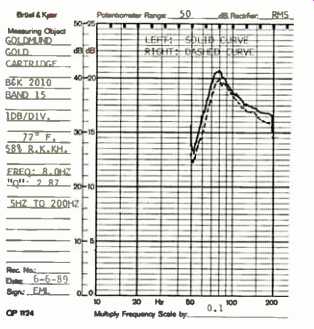
Fig. 2--Low-frequency tonearm/cartridge resonance is at 8.0 Hz with a Q of
2.87.
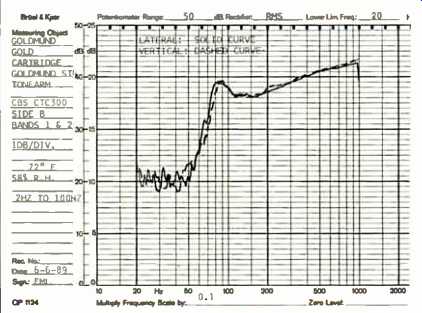
Fig. 3--Response to vertical and horizontal modulation from 2 to 100 Hz (slow
sweep). Note that the response is virtually identical in either plane.
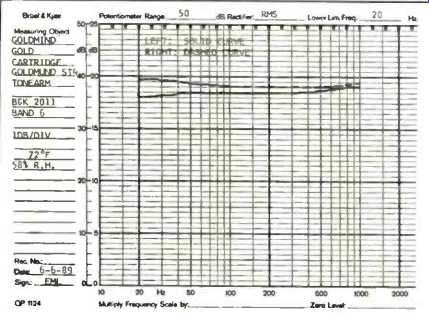
Fig. 4--Slow sweep from 20 to 1,000 Hz to check for structural resonances in
the arm.
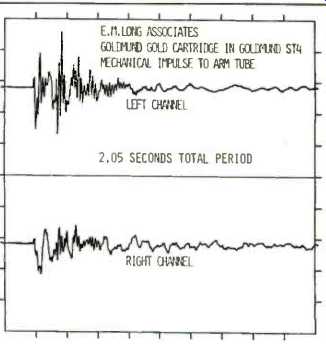
Fig. 5--Output vs. time of arm/cartridge when mechanical impulse was applied
to armtube, with arm lifted.
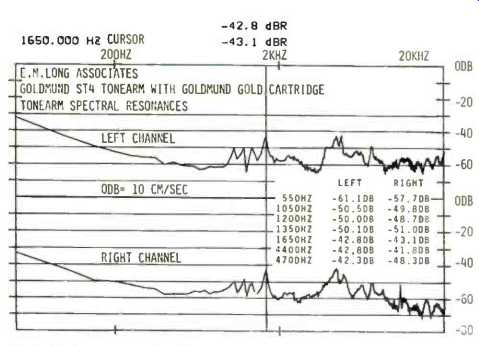
Fig. 6--Spectral output (averaged) of arm/ cartridge for sixteen mechanical
impulses applied to armtube.
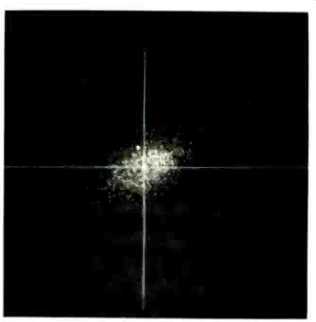
Fig. 7--Interchannel phase of cartridge, using pink noise from B & K 2011,
band 7.

Fig. 8--Interchannel phase difference vs. frequency. Phase difference at 20
kHz is 75.0° (10.4 µS).
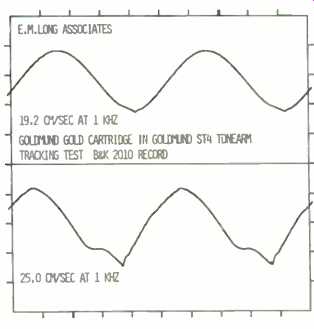
Fig. 9--Tracking of arm/ cartridge with 1-kHz test tones at 19.2 cm/S (top)
and 25.0 cm/S (bottom), using B & K 2010. Some asymmetry is apparent
at the higher level.
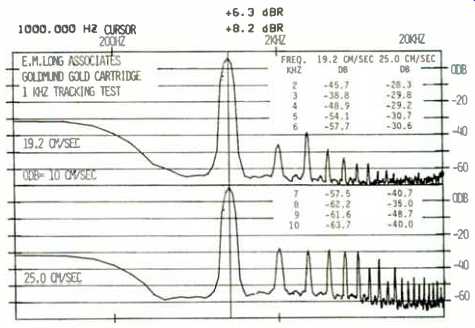
Fig. 10-Spectral analysis of the cartridge output when reproducing the signals
of Fig. 9. The third harmonic is 0.7% (-45.1 dB) at 19.2 cm/S and 1.2%
(-38.0 dB) at 25.0 cm/S.
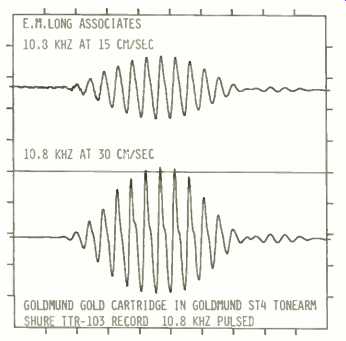
Fig. 11--Output for 10.8-kHz pulse test at levels of 15 and 30 cm/S, using
Shure TTR-103 test record, bands 1 and 4. Notice the step in the negative-going
portion of the wave.
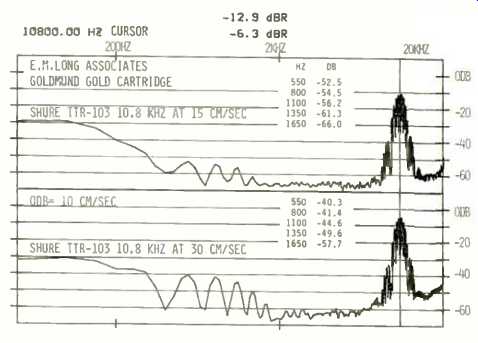
Fig. 12--Spectral analysis of distortion from signals shown in Fig. 11 (average
of 16 samples at each level). The highest level tone burst at 30 cm/S results
in less than 1.0% distortion, but the components are in the low to middle
frequency range, which can be perceived quite easily.
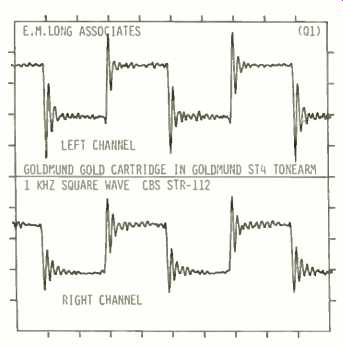
Fig. 13--Output from 1-kHz square wave, using CBS STR-112 test record.
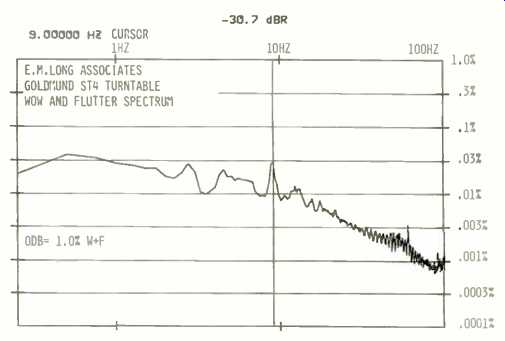
Fig. 14--Wow and flutter spectrum, from 0 to 100 Hz, of ST4 turntable. The
peak at about 9.0 Hz is due to the arm/cartridge resonance.
Stylus is resting in a groove near the middle of the record.
The square wave shown in Fig. 13 verifies that the Goldmund Gold's stylus cantilever has little or no damping.
These square waves are reminiscent of those from the Decca cartridge, which also has no damping. My own personal taste leans in this direction, since I don't see the waveforms riding on the square wave as "ringing" but rather as the delay of energy which appears later than it should, due to time delay. A perfect square wave requires that all of the harmonic components remain in precise relationship with each other. When a square wave is run through a lowpass filter (which is another way of stating what a phono cartridge is), its higher frequencies are delayed. Figure 13 shows this, but it isn't as bad as it looks, especially when one considers what a "Band-Aid" damping can be when it is used in an attempt to fix a delay phenomenon.
Figure 14 shows the wow and flutter spectrum for the Goldmund ST4 turntable. If any components of this spectrum stood out, they would indicate mechanical problems.
Here there are none, except at the tonearm/cartridge resonance, which always exaggerates the output. No comments were made by the listening panel, even during piano selections, that would indicate that the ST4 had any wow or flutter problems. I consider the information shown in Fig. 14 much more valuable than a single numerical reading from a meter, whose pointer is jumping back and forth in a manner similar to that shown in Fig. 15. I do take readings, and they appear in the "Measured Data" Table, but I don't trust them as I do the information in Fig. 14.
Variation in speed over a 42-S period is shown in Fig. 15.
Except for some rapid spikes that I am at a loss to explain, the speed stability was very good. The jaggedness of the waveform, due to cogging of the direct-drive servo system, can be seen but apparently not heard. Speed variation is also shown in Fig. 16, as a plot of frequency variation over time. The center frequency is 3,155 Hz, 5 Hz higher than the 3,150-Hz tone on the record; this shows that the ST4 is running 0.16% fast. The range of speed variation is very small and must be considered excellent.
Figure 17 shows the rumble spectrum. Rumble is very low except, as is always the case, at the tonearm/cartridge resonance. No comments were made about rumble by any panel members.

Fig. 15--Speed drift over 42-S period. Cyclic variations at 1.8 S, or 0.56 Hz,
are related to the rotational speed of 33 1/3 rpm.
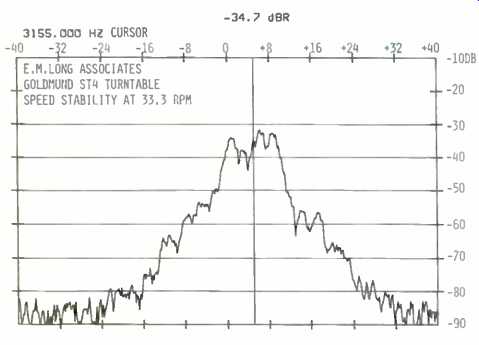
Fig. 16-Speed accuracy and stability, for 3,150-Hz tone on B & K 2010,
band 8. Drift is 0.317%.
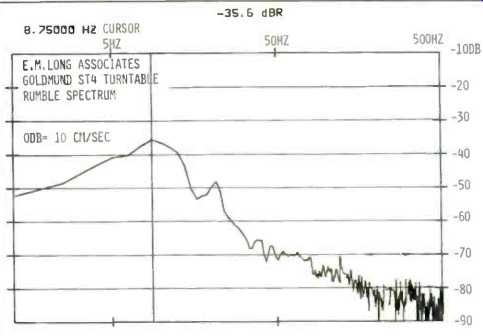
Fig. 17--Rumble spectrum. Most of the output is at the arm/ cartridge resonance.
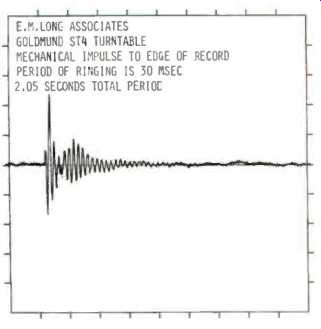
Fig. 18—Energy-absorption test, showing output vs. time for mechanical impulse
applied to edge of a stationary record, with stylus resting in groove.
The ability of the Goldmund platter and clamp to dissipate energy from the record is indicated by Figs. 18 and 19. Figure 18 shows output versus time for a mechanical impulse applied to the record's edge while the Gold cartridge's stylus rested in a stationary groove. Figure 19, the spectral output for a series of applied mechanical shocks, shows that energy reduction is not only very good but also, except from about 100 to 300 Hz, very uniform. The output shown in Fig. 18 does indicate that some delayed energy is present that could enhance the spatial qualities of the reproduction.
Figure 20 shows the output versus time for a mechanical shock applied to the platform on which the Goldmund ST4 turntable base was resting. The results indicate that the main resonance of the whole system is at 12.5 Hz; the platform suspension resonance was checked separately and found to be at 6.67 Hz. The spectrum shown in Fig. 21 shows a rise at 175 Hz, the source of which I was not able to determine.
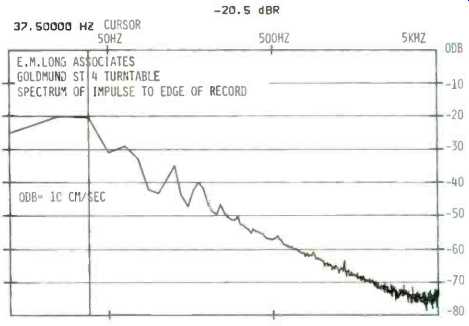
Fig. 19--Spectrum to 5 kHz of output from a series of 16 mechanical impulses
(averaged) applied to the edge of a stationary record, with stylus resting
in groove.
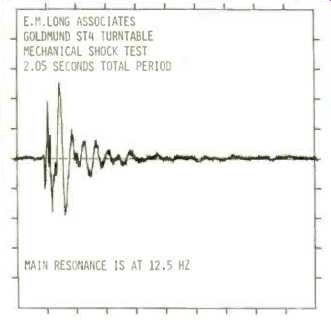
Fig. 20--Output vs. time for mechanical shock applied to platform on which
the turntable rested.

Fig. 21--Spectrum to 5 kHz of the vibrations caused by mechanical shocks
to support platform (16 impulses, averaged).
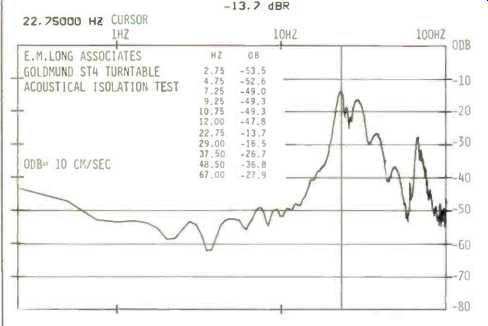
Fig. 22--Spectrum of acoustical breakthrough from an acoustic field of 100
dB SPL at the surface of a record.
The spectrum of the acoustical breakthrough is shown in Fig. 22. The sound level was maintained at 100 dB SPL at the surface of the record while a tone was slowly swept from 20 to 100 Hz. The output is quite high, which indicates that the turntable system should not be located close to the loudspeakers.
Conclusions
For the cost of the Goldmund ST4, one expects superb performance. While there are some things that could be improved, such as the suspension, the Goldmund ST4 turntable and tonearm and the Goldmund Gold cartridge do provide a very high level of performance. Because no sane person would buy a component this costly merely on the recommendation of a reviewer, my telling you to audition the ST4 before buying would be unnecessary. Nevertheless, I will caution you that, when you do listen to it, you should be aware of two things that I became convinced of during the number of months I have had the ST4. First, the ST4 and the Gold can complement certain loudspeaker systems in such a way as to provide exceptional results, while not necessarily being an optimum choice for use with others. Second, the ST4 must be set up and adjusted with great care to achieve the results described in this report. If there is any exaggerated brightness or harshness, then you are probably not hearing the sound the ST4 is capable of when properly adjusted. When you do, you may decide that the ST4 is actually a bargain and that Compact Discs are great for background music.
--Edward M. Long
(Source: Audio magazine, Aug. 1990)
Also see: Technics EPC-205CMk4 Cartridge (Jan. 1986)
Grace F-9E Ruby Phono Cartridge (July 1983)
Goldmund Mimesis 7 Preamp and Mimesis 6 Amp (Dec. 1989)
= = = =